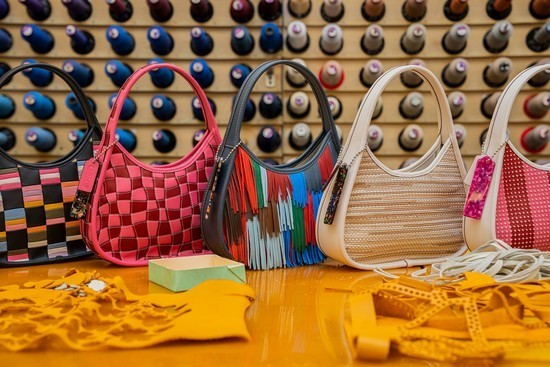During an interview late last
month, Stuart Vevers, the creative director of Coach, stood by slivers of
mustard-colored leather spread across a table at the Coach headquarters in New
York City. They were byproducts from the production line for the company’s
luxury handbags.
اضافة اعلان
“Waste scraps like this would normally end
up on a factory floor before being burned or in a landfill in huge volumes,”
Vevers said via video. “That’s just the way it has always been.”
But as the fashion industry comes under
increasing scrutiny for its wasteful practices, a team at Coach has spent the
past two years trying to figure out how to embrace more circular business
models, a concept that emphasizes minimizing the use of resources and making products
easier to recycle and reuse.
“The idea behind Coachtopia is to not just create new and beautiful craft from waste but also to close the loop by designing out waste in the first place.”
This week, the company introduced
Coachtopia, a line that offers nearly 100 products including bags, accessories,
ready-to-wear fashion, and footwear made primarily with waste leather sourced
from India and Vietnam or partly recycled materials like cotton, resin, or
polyester. Prices range from $75 for a T-shirt to $495 for the most expensive
handbag.
With motifs like fluffy clouds and flowers,
the 1970s-infused aesthetic of Coachtopia is designed to fill people with hope,
rather than anxiety about the future. Cornerstones are the Ergo and Wavy Dinky,
shoulder bags available in a wide variety of colors and artisanal designs,
including a checkerboard pattern, with each square made from dozens of woven
leather scraps like those that had been spread out in the workshop.
From Coach to Coachtopia“The idea behind Coachtopia is to not just
create new and beautiful craft from waste but also to close the loop by
designing out waste in the first place,” Vevers said. The challenge is to find
a circular system that actually works, he added.
 Recycled materials used in
Coachtopia, a new sub-brand from the American fashion house.
Recycled materials used in
Coachtopia, a new sub-brand from the American fashion house.
Initially, this will mean using waste or
recycled materials from Coach factories. Eventually, materials would also come
from older Coachtopia products, which customers will be able to return to Coach
for credit and are being designed to be repurposed more easily.
Much of the groundwork for Coachtopia comes
from (Re)Loved, a program the company started in 2021 that sells remade
handbags and allows customers to trade in older designs.
Capsule collections or “sustainable” lines
are common in fashion, and many critics see them as marketing opportunities
with minimal impact. Coach itself has been scrutinized for its sustainability
strategies after a viral TikTok video in 2021 alleged that it was destroying
unsold handbags, a widespread industry practice. In response, Coach said it
would cease the destruction of “in-store returns of damaged and unsalable
goods”.
The intended consumer for Coachtopia is Generation Z, who will represent 40 percent of the luxury goods market by 2035, according to a 2022 report from Bain, a consulting firm.
Joon Silverstein, the head of Coachtopia,
said that she hoped the process of figuring out the logistics of producing a
line that hews to such circular standards, and making it profitable, could be
used as a blueprint for how to improve the overall environmental footprint of
Coach, which made net sales of $4.9 billion in 2022.
Selling to a young marketThe intended consumer for Coachtopia is
Generation Z, who will represent 40 percent of the luxury goods market by 2035,
according to a 2022 report from Bain, a consulting firm. A community of young
collaborators was invited to consult on designs and marketing campaigns for
current and future collections. Coachtopia prices are deliberately lower than
those of Coach and other luxury rivals in order to make products more
accessible to younger shoppers.
Francois Souchet, the global head of
sustainability and impact consulting at BPCM, a consulting firm, said that
sustainability credentials could not compensate for design or brand appeal.
 Coachtopia’s handbag styles
include a checkerboard design, sequin cutouts and swishy layers of fringe.
Coachtopia’s handbag styles
include a checkerboard design, sequin cutouts and swishy layers of fringe.
“The selling point is the product, and then
how it’s made is the cherry on top,” Souchet said. “A product can only really
be successful if people want it. What we see currently is that circular craft
might make a customer more excited about a product but it is unlikely to drive
the purchase itself.”
Vevers, who has been exploring and
emphasizing sustainability more deeply on the Coach runway in recent seasons,
said the process has been an important learning experience. He noted that it
was “impossible for anyone working in this business to ignore how broken a
linear system of producing, distributing and using most clothing is”.
Read more Fashion
Jordan News





